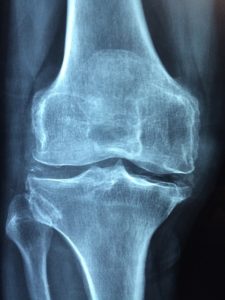According to the Centers for Disease Control (CDC) an estimated 52.5 million adults have been diagnosed with arthritis. Of those, 22.7 million report everyday limitations as a result of the disease.[1] One of the most common forms of knee pain is known as Osteoarthritis or (OA). It’s most common in people over 50, although it can affect younger people too.[2] It can develop over time, as cartilage begins to wear away and bone begins to rub directly on bone causing pain.
Suffering with osteoarthritis in the knees can have a major impact on your everyday movement, mobility, comfort and independence . Things people without knee pain take for granted like walking, standing, climbing stairs and even standing up from a seated position can become difficult and painful. It’s no wonder many people suffering with knee pain are desperate to find solutions that can help.
Treatment Options
 Treatment options range depending on the cause and severity of your knee pain. As always, it’s best to consult with a medical professional to determine whether surgical or non-surgical options are the best solution for you. If you can avoid surgery here are some treatment options to consider that may help reduce or relieve the pain, stiffness and inflammation.
Treatment options range depending on the cause and severity of your knee pain. As always, it’s best to consult with a medical professional to determine whether surgical or non-surgical options are the best solution for you. If you can avoid surgery here are some treatment options to consider that may help reduce or relieve the pain, stiffness and inflammation.
Lifestyle Changes & Exercise
If there are situations that seem to aggravate your knee pain look for alternatives whenever possible. For instance taking an elevator instead of climbing stairs, can help reduce your discomfort. If you currently engage in activities that are hard on your knees like jogging look for alternatives that are less jarring. While we’re on the subject of activity, engaging in exercises like swimming, walking, yoga and tai-chi (which help strengthen the muscles that support your knees) may help reduce your pain and increase mobility.
Lose Weight
Maintaining a healthy weight can help reduce the burden placed on your knees. Your knee joints have the greatest load-bearing capacity of any of your leg joints. In fact, when you’re walking or standing on one leg the load is roughly equivalent to twice your body weight. [3]
Losing just a little weight can have big effects. Research shows that each 1-pound loss reduces the load on the knees by about 4 pounds. Dropping about 5% of body weight reduces pain and improves one’s ability to move, and losing a more significant amount – 10% or more – slows the disease process, according to a large trial of people with knee OA. Research published in the Journal of the American Medical Association in 2013 shows weight loss also lowers levels of the bodywide inflammation that contributes to joint damage in OA and related conditions. – http://www.arthritis.org/living-with-arthritis/treatments/natural/other-therapies/nondrug-approaches-knee-oa.php
Physical Therapy
Trained physical and occupational therapists can help by:
- providing exercises to increase your range of motion and flexibility;
- teaching you how to work out stiffness without further damaging your joint;
- teaching you how to reduce strain on your joints during daily activities;
- recommending devices that can assist you in performing everyday tasks.
Over the Counter Medications
There are a number of over the counter (OTC) medications that may help reduce our pain. WebMD provides a comprehensive list of OTC medications that include aspirin, ibuprofen and naproxen. While these can be effective at reducing pain they do increase your risk for potential side effects.
For moderate-to-severe joint pain with swelling, an over-the-counter or prescription nonsteroidal anti-inflammatory drug (NSAID) such as aspirin, ibuprofen (Advil, Motrin), or naproxen sodium (Aleve), can provide relief. A newer generation of NSAIDs known as Cox-2 inhibitors (celcoxib) is also good for pain relief, but all except one of these drugs (Celebrex) have been removed from the market because of an increased risk of heart attack, stroke, and other cardiovascular events. NSAIDs also can have side effects, potentially increasing your risk for gastrointestinal bleeding. – http://www.webmd.com/pain-management/guide/joint-pain#1
Other Treatments
In addition to exercise, weight-loss, physical therapy and OTC medications, other alternative treatments may provide temporary relief from pain such as:
- using pain-relieving creams;
- applying heat or cold;
- and wearing supportive bandages.
Many people who want to take a more natural approach select products like Oceanic Naturals Mussel Relief which has unique anti-inflammatory properties that help relieve inflammation and reduce joint pain without the dangerous side effects you may experience using NSAIDs and other OTC medicines.
Conclusion
There are a number of alternative treatments available for you if you suffer with knee pain and are in a position to avoid surgery. Consult with your medical professional to determine which option(s) may be right for you.
References
-
Arthritis. (2015, July 22). Retrieved July 11, 2016, from http://www.cdc.gov/chronicdisease/resources/publications/aag/arthritis.htm
-
Arthritis of the Knee-OrthoInfo – AAOS. (2014, June 1). Retrieved July 11, 2016, from http://orthoinfo.aaos.org/topic.cfm?topic=a00212
-
Sugiura, H., & Demura, S. (2013, July 18). Effects of Mild and Severe Knee Joint Pain on Various Activities of Daily Living in the Female Elderly. Retrieved July 11, 2016, from http://www.hindawi.com/journals/prt/2013/989508/
Disclaimer: SelfCare Plus sells Oceanic Naturals Mussel Relief product direct to consumers.




